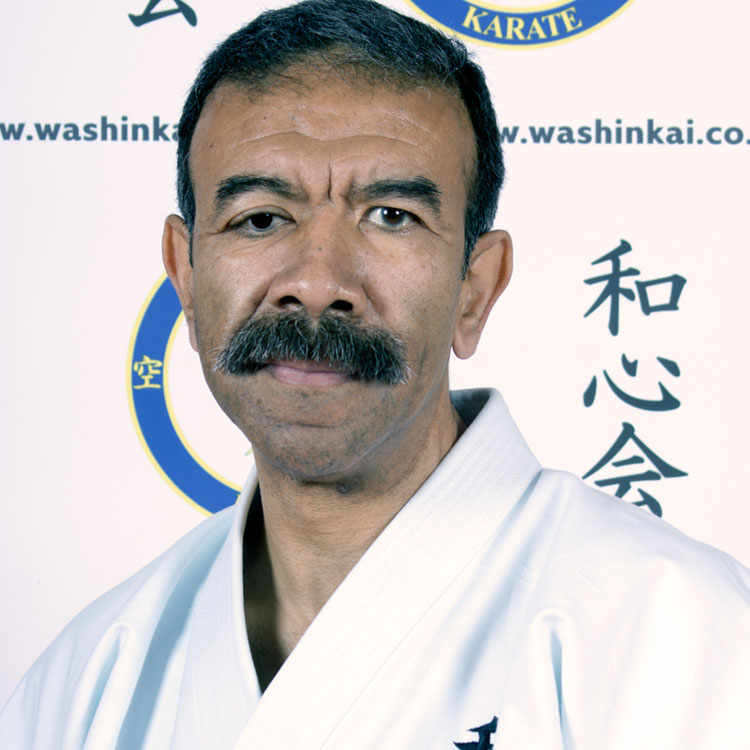
Since the early 1970s, Chris Thompson has been at the forefront of karate in England. Chris Thompson began studying karate in 1969 and remembers the date well as during his first class Neil Armstrong was orbiting and about to land on the moon.
During his early years he trained with many of the first Japanese Wado Ryu instructors to come to England and Europe. Instructors such as Suzuki, Fuji, Maeda and later Kitamura, Kobayashi and Shinohara all played a part in his early karate training.
A successful competitor in kata and kumite, it wasn’t long before Chris Thompson was teaching and in 1978 formed the Washinkai Karate Organisation.
Throughout the 1980s, Chris Thompson was the Southern representative of the British Karate Association (BKA) helping to maintain the high standard from Associations applying for membership of that organisation.
Now Chris is elected Chairman and Chief Instructor of the British Traditional Karate Association, an organisation that has had and continues to have many competition successes in Kata and Kumite, both nationally and internationally.
Born out of his experiences home and abroad, training with other Japanese instructors from the four major schools of karate, Shotokan, Goju Kai, Shito Ryu and Wado Ryu, the Washinkai style is an eclectic style with firm Wado roots.
A successful author and star of the video series “Essentials of Karate” Chris Thompson holds the rank of 9th Dan and held the post of Technical Director for English Karate for many years.
In late 1977 Chris Thompson had become disillusioned with the Wado Organisation in UK. He then decided that it would be best to severe all connection with them.
Chris Thompson therefore became one of the earliest to break away from the Japanese system in England. He was also one of the first Englishmen to formulate his own style, training and grading syllabus, which was subsequently recognised by the Japanese Karate Federation.
With many of his senior students feeling the same way they officially left the Wado Ryu group in 1978.
I now went searching for a new home, which involved training with various senior instructors of different schools of karate. This period was invaluable as it broadened my horizons, giving me an insight into the different approach that other instructors had in teaching karate. I made many good friends. For over a year I continued with this programme whilst running several clubs. I admired many aspects of all the karate schools I trained with, but I felt that none could offer exactly what I was looking for. Unbeknown to me at the time I was following the step of Shu-ha-ri.
– Shihan Chris Thompson (9th Dan) Essentials of Wado Ryu
With five clubs spread over London a name to identify with was needed. Collectively they called themselves ‘Wa-shin-kai’ . Wa – for harmony as Chris Thompson’s roots were with Wado-Ryu; Shin – for heart, mind and spirit as one, also truth; Kai – for group.
Chris Thompson felt that a specific growth programme for Washinkai had to be created. This was important if the group was going to survive as an independent group and there were to be no contradictions in teaching methods or technique.
Two Japanese instructors, Hironori Goda, a Goju stylist and Takao Yamamoto, a Shito-ryu stylist, stayed and trained with Washinkai for long periods. Over the next few years a grading syllabus was established that took the student from beginner to Shodan (black belt).
Both of these Japanese men continued with the Washinkai teaching programme on their return to Japan.
Washinkai’s growth was not rapid as they specifically adhered to the policy of growth from within, a policy still in force 40 years later.
Over the years Washinkai evolved in to a Wado-Ryu based style, becoming more than just a collective name the association was called Washinkai Karate Do Renmei.
In 1997, for many reasons the association changed it’s name to the British Traditional Karate Association, who still practice Washinkai Karate.
Today the BTKA has many clubs throughout the South of England and in countries such as Norway, Spain, Portugal and the USA. All still adhere to the original ideas of Washinkai Karate. The BTKA is a respected member of the karate world and many groups have styled themselves on the original concept of Washinkai and the BTKA.
The Washinkai Timeline
- 1965: Karate Arrives in Britain with Japanese experts residing in the UK
- 1969: Chris Thompson Starts Karate
- 1973: Wado-Ryu Organisation splits
- 1977: All Ties With Wado in the UK Severed
- 1978: Washinkai Inaugural Instructors Course
- 1982: Hinori Ohtsuka (Founder Wado Ryu) dies
- 1985: Washinkai Joins British Karate Association (BKA)
- 1991: Washinkai becomes a Founder Member of the English Karate Governing Body (EKGB)
- 1995: Chris Thompson appointed Secretary of the EKGB Technical Committee
- 1997: Washinkai Karate-Do Renmei changes name to British Traditional Karate Association
- 2002: Chris Thompson appointed Technical Chairman of the EKGB
- 2003: BTKA Celebrates 25 Years of Washinkai
- 2007: BTKA Celebrates 30 Years of Washinkai
- 2007: Shihan Thompson awarded 8th Dan
- 2008: Chris Thompson appointed Technical Director of the English Karate Federation (EKF)
- 2009: Shihan Thompson celebrates 40 years of continuous training in Karate!
- 2017: Washinkai celebrates 40th Anniversary since its creation
- 2017: March – Shihan Chris Thompson awarded 9th Dan
- 2019: Chris Thompson resigns as Technical Director of the EKF
- 2019: Shihan Thompson celebrates 50 years of continuous karate!
- 2023: Association Championships held after two-year absence due to Covid-19
- 2025: BTKA becomes a Founder Member of the new governing body for karate in England, the EKNGB (English Karate National Governing Body)





